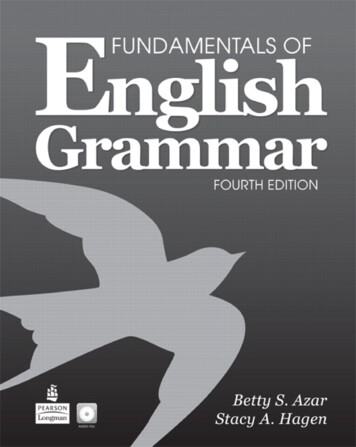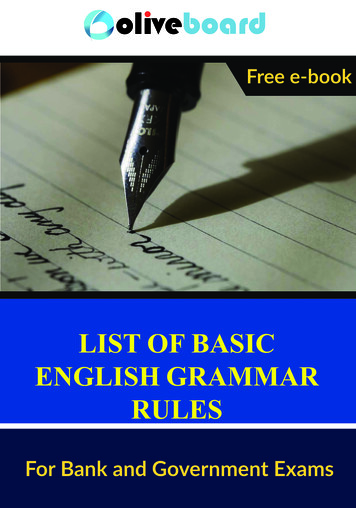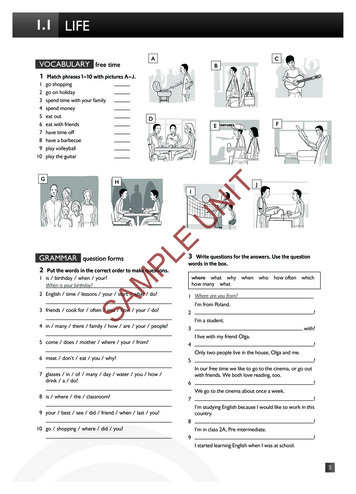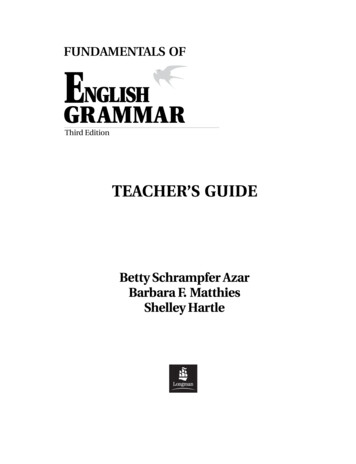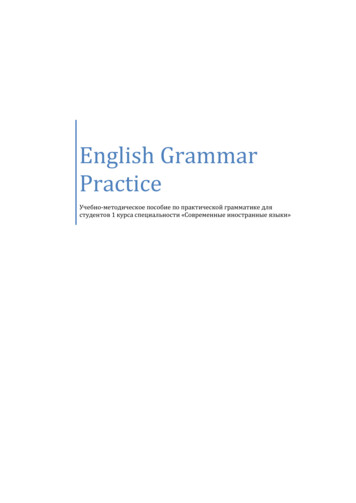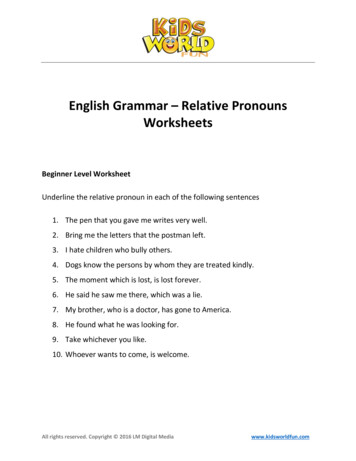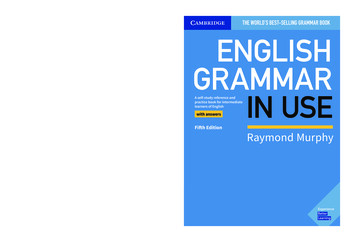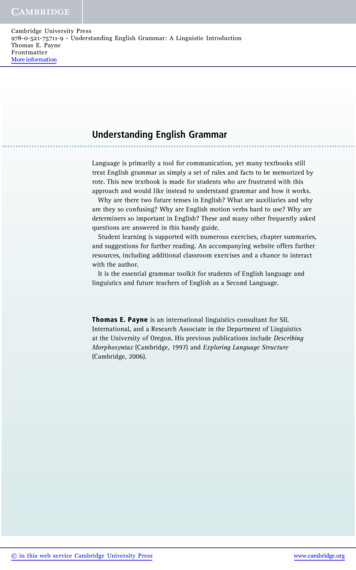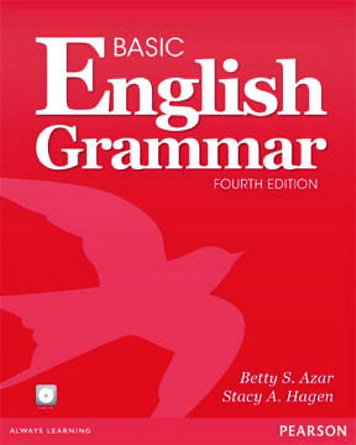
Transcription
# 108791A01 BEG SB 2249 FM.indd1Cust: PH/Pearson Au: Azar Pg. No. iC/KDESIGN SERVICES OFs4carlisle11/3/13 2:57 PM
ContentsPreface to the Fourth Edition. . . . . . . . . . . . . . . . . . . . . . . . . . . . . . . . . . . . . . . . . . . xiAcknowledgments. . . . . . . . . . . . . . . . . . . . . . . . . . . . . . . . . . . . . . . . . . . . . . . . . . . xvChapter 1USING BE. . . . . . . . . . . . . . . . . . . . . . . . . . . . . . . . . . . . . . . . . . . . . . . . . . . 11-1 Singular pronouns be. . . . . . . . . . . . . . . . . . . . . . . . . . . . . . . . . . . . . . . . . 21-2 Plural pronouns be. . . . . . . . . . . . . . . . . . . . . . . . . . . . . . . . . . . . . . . . . . . 41-3 Singular nouns be. . . . . . . . . . . . . . . . . . . . . . . . . . . . . . . . . . . . . . . . . . . . 61-4 Plural nouns be. . . . . . . . . . . . . . . . . . . . . . . . . . . . . . . . . . . . . . . . . . . . . 81-5 Contractions with be . . . . . . . . . . . . . . . . . . . . . . . . . . . . . . . . . . . . . . . . . . 111-6 Negative with be. . . . . . . . . . . . . . . . . . . . . . . . . . . . . . . . . . . . . . . . . . . . . . 131-7 Be adjective . . . . . . . . . . . . . . . . . . . . . . . . . . . . . . . . . . . . . . . . . . . . . . . 161-8 Be a place. . . . . . . . . . . . . . . . . . . . . . . . . . . . . . . . . . . . . . . . . . . . . . . . . 211-9 Summary: basic sentence patterns with be . . . . . . . . . . . . . . . . . . . . . . . . . . 24Chapter 2USING BE AND HAVE. . . . . . . . . . . . . . . . . . . . . . . . . . . . . . . . . . . . . . . . . 282-1 Yes/no questions with be . . . . . . . . . . . . . . . . . . . . . . . . . . . . . . . . . . . . . . . 282-2 Short answers to yes/no questions. . . . . . . . . . . . . . . . . . . . . . . . . . . . . . . . . 302-3 Questions with be: using where. . . . . . . . . . . . . . . . . . . . . . . . . . . . . . . . . . 322-4 Using have and has. . . . . . . . . . . . . . . . . . . . . . . . . . . . . . . . . . . . . . . . . . . 342-5 Using my, your, her, his, our, their . . . . . . . . . . . . . . . . . . . . . . . . . . . . . 392-6 Using this and that . . . . . . . . . . . . . . . . . . . . . . . . . . . . . . . . . . . . . . . . . . . 452-7 Using these and those. . . . . . . . . . . . . . . . . . . . . . . . . . . . . . . . . . . . . . . . . 482-8 Asking questions with what and who be . . . . . . . . . . . . . . . . . . . . . . . . . 52Chapter 3USING THE SIMPLE PRESENT. . . . . . . . . . . . . . . . . . . . . . . . . . . . . . . . . . . . 593-1 Form and basic meaning of the simple present tense. . . . . . . . . . . . . . . . . . . 593-2 Frequency adverbs . . . . . . . . . . . . . . . . . . . . . . . . . . . . . . . . . . . . . . . . . . . . 623-3 Position of frequency adverbs. . . . . . . . . . . . . . . . . . . . . . . . . . . . . . . . . . . . 653-4 Spelling and pronunciation of final -es. . . . . . . . . . . . . . . . . . . . . . . . . . . . . 673-5 Adding final -s/-es to words that end in -y. . . . . . . . . . . . . . . . . . . . . . . . . . 693-6 Irregular singular verbs: has, does, goes . . . . . . . . . . . . . . . . . . . . . . . . . . . 703-7 Like to, want to, need to. . . . . . . . . . . . . . . . . . . . . . . . . . . . . . . . . . . . . . 743-8 Simple present tense: negative. . . . . . . . . . . . . . . . . . . . . . . . . . . . . . . . . . . . 763-9 Simple present tense: yes/no questions . . . . . . . . . . . . . . . . . . . . . . . . . . . . . 823-10 Simple present tense: asking information questions with whereand what. . . . . . . . . . . . . . . . . . . . . . . . . . . . . . . . . . . . . . . . . . . . . . . . . . . 863-11 Simple present tense: asking information questions with whenand what time. . . . . . . . . . . . . . . . . . . . . . . . . . . . . . . . . . . . . . . . . . . . . . . 89vii
Chapter 4USING THE PRESENT PROGRESSIVE. . . . . . . . . . . . . . . . . . . . . . . . . . . . . . 964-1 Be -ing: the present progressive. . . . . . . . . . . . . . . . . . . . . . . . . . . . . . . . 964-2 Spelling of -ing . . . . . . . . . . . . . . . . . . . . . . . . . . . . . . . . . . . . . . . . . . . . . 1004-3 Present progressive: negatives. . . . . . . . . . . . . . . . . . . . . . . . . . . . . . . . . . . 1024-4 Present progressive: questions. . . . . . . . . . . . . . . . . . . . . . . . . . . . . . . . . . . 1054-5 Simple present tense vs. the present progressive . . . . . . . . . . . . . . . . . . . . . 1104-6 Non-action verbs not used in the present progressive . . . . . . . . . . . . . . . . . 1164-7 See, look at, watch, hear, and listen to. . . . . . . . . . . . . . . . . . . . . . . . . . 1184-8 Think about and think that. . . . . . . . . . . . . . . . . . . . . . . . . . . . . . . . . . . 121Chapter 5TALKING ABOUT THE PRESENT. . . . . . . . . . . . . . . . . . . . . . . . . . . . . . . . . 1255-1 Using it to talk about time . . . . . . . . . . . . . . . . . . . . . . . . . . . . . . . . . . . . . 1255-2 Prepositions of time . . . . . . . . . . . . . . . . . . . . . . . . . . . . . . . . . . . . . . . . . . 1275-3 Using it and what to talk about the weather. . . . . . . . . . . . . . . . . . . . . . . . 1305-4 There be . . . . . . . . . . . . . . . . . . . . . . . . . . . . . . . . . . . . . . . . . . . . . . . . 1335-5 There be: yes/no questions. . . . . . . . . . . . . . . . . . . . . . . . . . . . . . . . . . . 1355-6 There be: asking questions with how many . . . . . . . . . . . . . . . . . . . . . 1375-7 Prepositions of place. . . . . . . . . . . . . . . . . . . . . . . . . . . . . . . . . . . . . . . . . . 1385-8 More prepositions of place: a list. . . . . . . . . . . . . . . . . . . . . . . . . . . . . . . . . 1425-9 Would like. . . . . . . . . . . . . . . . . . . . . . . . . . . . . . . . . . . . . . . . . . . . . . . . . 1495-10 Would like vs. like . . . . . . . . . . . . . . . . . . . . . . . . . . . . . . . . . . . . . . . . . . 151Chapter 6NOUNS AND PRONOUNS. . . . . . . . . . . . . . . . . . . . . . . . . . . . . . . . . . . . . 1596-1 Nouns: subjects and objects . . . . . . . . . . . . . . . . . . . . . . . . . . . . . . . . . . . . 1596-2 Nouns as objects of prepositions. . . . . . . . . . . . . . . . . . . . . . . . . . . . . . . . . 1616-3 Adjectives with nouns. . . . . . . . . . . . . . . . . . . . . . . . . . . . . . . . . . . . . . . . . 1646-4 Subject pronouns and object pronouns. . . . . . . . . . . . . . . . . . . . . . . . . . . . 1666-5 Nouns: singular and plural forms . . . . . . . . . . . . . . . . . . . . . . . . . . . . . . . . 1706-6 Nouns: irregular plural forms . . . . . . . . . . . . . . . . . . . . . . . . . . . . . . . . . . . 1746-7 Possessive pronouns: mine, yours, his, hers, ours, theirs. . . . . . . . . . . . 1786-8 Possessive nouns. . . . . . . . . . . . . . . . . . . . . . . . . . . . . . . . . . . . . . . . . . . . . 1816-9 Questions with whose . . . . . . . . . . . . . . . . . . . . . . . . . . . . . . . . . . . . . . . . 1856-10 Possessive: irregular plural nouns . . . . . . . . . . . . . . . . . . . . . . . . . . . . . . . . 187Chapter 7COUNT AND NONCOUNT NOUNS. . . . . . . . . . . . . . . . . . . . . . . . . . . . . . 1917-1 Nouns: count and noncount. . . . . . . . . . . . . . . . . . . . . . . . . . . . . . . . . . . . 1917-2 Using a vs. an . . . . . . . . . . . . . . . . . . . . . . . . . . . . . . . . . . . . . . . . . . . . . . 1967-3 Using a/an vs. some . . . . . . . . . . . . . . . . . . . . . . . . . . . . . . . . . . . . . . . . . 1987-4 Measurements with noncount nouns. . . . . . . . . . . . . . . . . . . . . . . . . . . . . . 2047-5 Using many, much, a few, a little. . . . . . . . . . . . . . . . . . . . . . . . . . . . . . 2087-6 Using the. . . . . . . . . . . . . . . . . . . . . . . . . . . . . . . . . . . . . . . . . . . . . . . . . . 2117-7 Using Ø (no article) to make generalizations. . . . . . . . . . . . . . . . . . . . . . . . 2157-8 Using some and any. . . . . . . . . . . . . . . . . . . . . . . . . . . . . . . . . . . . . . . . . 217Chapter 8EXPRESSING PAST TIME, PART 1. . . . . . . . . . . . . . . . . . . . . . . . . . . . . . . . 2248-1 Using be: past time. . . . . . . . . . . . . . . . . . . . . . . . . . . . . . . . . . . . . . . . . . . 2248-2 Simple past tense of be: negative. . . . . . . . . . . . . . . . . . . . . . . . . . . . . . . . . 2268-3 Past of be: questions. . . . . . . . . . . . . . . . . . . . . . . . . . . . . . . . . . . . . . . . . . 2278-4 Simple past tense: using -ed. . . . . . . . . . . . . . . . . . . . . . . . . . . . . . . . . . . . 232viii CONTENTS
8-58-68-78-88-98-108-11Chapter 9Past time words: yesterday, last, and ago. . . . . . . . . . . . . . . . . . . . . . . . .Simple past tense: irregular verbs (Group 1). . . . . . . . . . . . . . . . . . . . . . . .Simple past tense: negative. . . . . . . . . . . . . . . . . . . . . . . . . . . . . . . . . . . . .Simple past tense: yes/no questions. . . . . . . . . . . . . . . . . . . . . . . . . . . . . . .Simple past tense: irregular verbs (Group 2). . . . . . . . . . . . . . . . . . . . . . . .Simple past tense: irregular verbs (Group 3). . . . . . . . . . . . . . . . . . . . . . . .Simple past tense: irregular verbs (Group 4). . . . . . . . . . . . . . . . . . . . . . . .235239243246251254257EXPRESSING PAST TIME, PART 2. . . . . . . . . . . . . . . . . . . . . . . . . . . . . . . . 2659-1 Simple past tense: using where, why, when, and what time . . . . . . . . . . 2659-2 Questions with what . . . . . . . . . . . . . . . . . . . . . . . . . . . . . . . . . . . . . . . . . 2699-3 Questions with who and whom. . . . . . . . . . . . . . . . . . . . . . . . . . . . . . . . . 2729-4 Simple past tense: irregular verbs (Group 5). . . . . . . . . . . . . . . . . . . . . . . . 2779-5 Simple past tense: irregular verbs (Group 6). . . . . . . . . . . . . . . . . . . . . . . . 2799-6 Simple past tense: irregular verbs (Group 7). . . . . . . . . . . . . . . . . . . . . . . . 2829-7 Before and after in time clauses. . . . . . . . . . . . . . . . . . . . . . . . . . . . . . . . . 2849-8 When in time clauses. . . . . . . . . . . . . . . . . . . . . . . . . . . . . . . . . . . . . . . . . 2879-9 Present progressive and past progressive. . . . . . . . . . . . . . . . . . . . . . . . . . . 2899-10 Using while with past progressive. . . . . . . . . . . . . . . . . . . . . . . . . . . . . . . . 2939-11 Simple past tense vs. the past progressive . . . . . . . . . . . . . . . . . . . . . . . . . . 294Chapter 10 EXPRESSING FUTURE TIME, PART 1. . . . . . . . . . . . . . . . . . . . . . . . . . . . . . 30310-1 Future time: using be going to. . . . . . . . . . . . . . . . . . . . . . . . . . . . . . . . . . 30310-2 Using the present progressive to express future time. . . . . . . . . . . . . . . . . . 30710-3 Words used for past time and future time. . . . . . . . . . . . . . . . . . . . . . . . . . 30910-4 Using a couple of or a few with ago (past) and in (future). . . . . . . . . . . . 31410-5 Using today, tonight, and this morning, afternoon, evening,week, month, year. . . . . . . . . . . . . . . . . . . . . . . . . . . . . . . . . . . . . . . . . . 31710-6 Future time: using will. . . . . . . . . . . . . . . . . . . . . . . . . . . . . . . . . . . . . . . . 31910-7 Asking questions with will . . . . . . . . . . . . . . . . . . . . . . . . . . . . . . . . . . . . . 32110-8 Verb summary: present, past, and future. . . . . . . . . . . . . . . . . . . . . . . . . . . 32510-9 Verb summary: forms of be. . . . . . . . . . . . . . . . . . . . . . . . . . . . . . . . . . . . . 327Chapter 11 EXPRESSING FUTURE TIME, PART 2. . . . . . . . . . . . . . . . . . . . . . . . . . . . . . 33411-1 May/might vs. will. . . . . . . . . . . . . . . . . . . . . . . . . . . . . . . . . . . . . . . . . . 33411-2 Maybe (one word) vs. may be (two words). . . . . . . . . . . . . . . . . . . . . . . . 33711-3 Future time clauses with before, after, and when. . . . . . . . . . . . . . . . . . . 34211-4 Clauses with if . . . . . . . . . . . . . . . . . . . . . . . . . . . . . . . . . . . . . . . . . . . . . . 34611-5 Expressing future and habitual present with time clausesand if-clauses. . . . . . . . . . . . . . . . . . . . . . . . . . . . . . . . . . . . . . . . . . . . . . . 34911-6 Using what a form of do . . . . . . . . . . . . . . . . . . . . . . . . . . . . . . . . . . . . 353Chapter 12 MODALS, PART 1: EXPRESSING ABILITY. . . . . . . . . . . . . . . . . . . . . . . . . . 36112-1 Using can. . . . . . . . . . . . . . . . . . . . . . . . . . . . . . . . . . . . . . . . . . . . . . . . . . 36112-2 Pronunciation of can and can’t. . . . . . . . . . . . . . . . . . . . . . . . . . . . . . . . . 36412-3 Using can: questions . . . . . . . . . . . . . . . . . . . . . . . . . . . . . . . . . . . . . . . . . 36512-4 Using know how to. . . . . . . . . . . . . . . . . . . . . . . . . . . . . . . . . . . . . . . . . . 36812-5 Using could: past of can . . . . . . . . . . . . . . . . . . . . . . . . . . . . . . . . . . . . . . 37012-6 Using be able to . . . . . . . . . . . . . . . . . . . . . . . . . . . . . . . . . . . . . . . . . . . . 37312-7 Using very and too adjective . . . . . . . . . . . . . . . . . . . . . . . . . . . . . . . . . 376CONTENTS ix
Chapter 13 MODALS, PART 2: ADVICE, NECESSITY, REQUESTS, SUGGESTIONS. . . . 38313-1 Using should. . . . . . . . . . . . . . . . . . . . . . . . . . . . . . . . . . . . . . . . . . . . . . . 38413-2 Using have infin
Basic English Grammar is accompanied by A comprehensive Workbook, consisting of self-study exercises for independent work. An all-new Teacher’s Guide, with step-by-step teaching suggestions for each chart, notes to the teacher on key grammar structures, vocabulary lists, and expansion activities. An expanded Test BankFile Size: 606KBPage Count: 39
